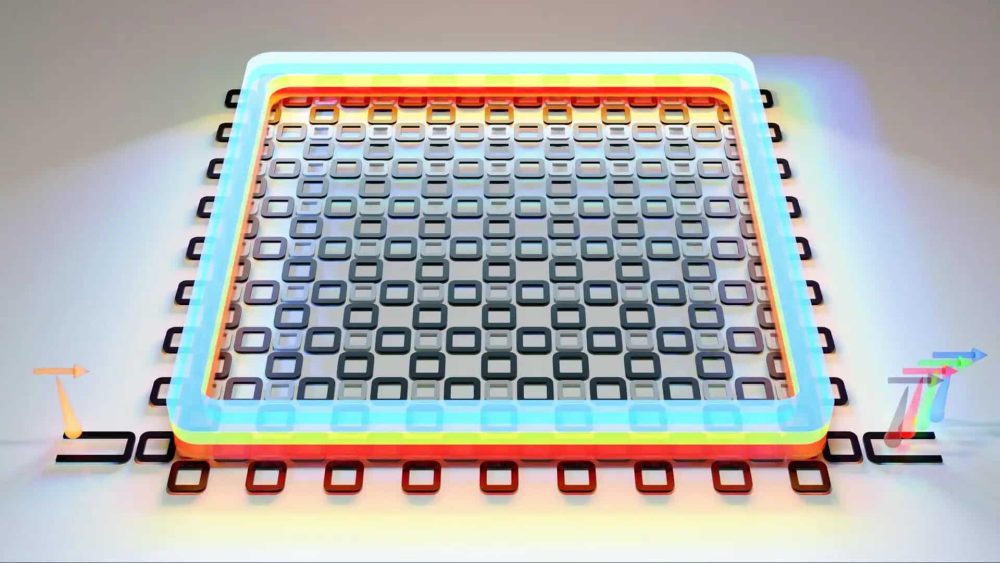Scientists have unveiled a new kind of photonic chip that can take a single color of laser light and quietly turn it into several new colors, all on its own, no fine-tuning, no extra electronics, no “lab magic” required.
The work, led by researchers at the Joint Quantum Institute (JQI) and the University of Maryland, could simplify future quantum computers, ultra-precise clocks, and high-speed communication systems that rely on ultra-stable, multi-color light sources. Their results were published in Science on November 6, 2025.
Why Do We Need Chips That Make New Colors Of Light?
Modern technology already leans heavily on lasers:
- Data centers use them to push huge amounts of information through optical fibers
- Precision clocks use them to measure time with ridiculous accuracy
- Emerging quantum technologies depend on very specific light frequencies to control atoms, ions, or photonic qubits
But there’s a problem: every new color (frequency) of laser usually means another separate laser, which adds cost, complexity, power consumption, and size. In some cases, the desired laser color doesn’t even exist commercially.
That’s why researchers have been chasing a dream: a chip that you feed with one laser color, and it spits out multiple new colors on demand, directly on the chip, ready to plug into existing systems.
This is exactly where the new photonic chips come in.
From “Bending Light” To “Creating New Light”
A regular glass prism splits light into colors that are already there. These new chips are different:
- They create new colors that weren’t present in the original beam.
- They do this through nonlinear optics, where intense light changes the material’s behavior and, in turn, transforms the light itself.
In nonlinear processes like second, third, and fourth harmonic generation:
- Two low-frequency photons can merge into one photon at double the frequency (second harmonic)
- Or three photons combine into a triple-frequency photon (third harmonic), and so on
The team’s chip can take telecom laser light at about 190 THz (standard in fiber networks) and convert it into its 2nd, 3rd, and 4th harmonics, which, for their setup, correspond to red, green, and blue light. Think: a single invisible telecom laser going in, and visible RGB light coming out.
The Big Headache: Making This Work Reliably
Nonlinear effects are notoriously fragile and tricky:
- The chip has to support multiple frequencies at once, like a musical instrument that can resonate at exactly the right notes.
- Those frequencies also have to travel in sync inside the resonator so they don’t “slip out of rhythm” with each other.
- Tiny differences in fabrication, just a few nanometers, can ruin the delicate conditions needed for efficient frequency conversion.
These requirements are called frequency–phase matching conditions, and they’re why nonlinear photonic chips are often hit-or-miss. You might design 100 chips and only a few actually behave the way you want.
The standard workaround is to add active tuning: tiny heaters on the chip that slightly change the material properties to push things into alignment. It works, but it:
- Adds complexity and power consumption
- Makes mass production harder
- Turns every chip into a mini science experiment
The Breakthrough: Let The Chip Do The Hard Work Passively
In earlier work, the JQI team had already explored chips with arrays of tiny ring resonators. These microscopic loops trap light and cause it to circulate hundreds of thousands or even millions of times.
In the new work, the researchers realized something surprising:
These ring arrays naturally create two timescales in the system:
- A fast loop: light racing around each small ring
- A slow loop: light effectively circulating around a larger “super-ring” formed by the whole array
This dual-timescale structure subtly alters how frequencies and phases align in the chip. Instead of requiring perfect, hand-tuned conditions, the chip effectively gives itself multiple chances to satisfy the frequency–phase-matching rules.
The result?
- They tested six different chips made on the same wafer.
- All six automatically generated second, third, and fourth harmonics from the same 190 THz input — no heaters, no tweaking.
- The devices worked over a broad range of input frequencies, not just under perfect lab conditions.
As lead researcher, Mahmoud Jalali Mehrabad put it:
“We don’t need heaters; we don’t have heaters. They work.”
For comparison, when they tested more traditional single-ring devices (even with heaters), only one of three produced second harmonic light, and only in a narrow operating window.
Photonics And The Real World
This new passive design could make integrated photonics more practical, scalable, and cheaper across several fields:
- Metrology and clocks
Frequency combs and multi-color reference lasers are critical for ultra-precise timing and measurement. A compact chip that passively generates multiple stable frequencies is a major win. - Telecom and data centers
Telecom lasers at 190 THz are already standard. Being able to convert that one “workhorse” laser into multiple useful colors on-chip could simplify optical hardware and reduce energy use. - Quantum technologies
Many quantum systems (ions, atoms, defects, photonic qubits) require very specific wavelengths. Instead of building a zoo of dedicated lasers, a single chip-based frequency converter could feed multiple quantum systems at once. - Nonlinear optical computing & signal processing
Nonlinear effects are the backbone of many advanced photonic computing schemes. Making these effects robust and reproducible opens the door to more practical photonic processors.
And perhaps the most important engineering takeaway:
This design relaxes the need for perfect fabrication and active tuning, tackling a long-standing barrier to mass-producing nonlinear photonic chips.


